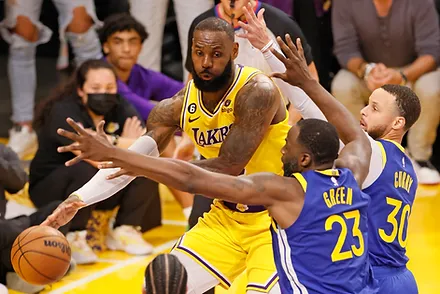
Introduction to the Lakers vs Golden State Warriors Rivalry
The rivalry between the Los Angeles Lakers and the Golden State Warriors is one of the most celebrated narratives in professional basketball. Over the decades, these two franchises have not only competed for victories but have also generated a significant cultural impact on the sport. This rivalry reflects a clash of titans, where both teams have showcased exceptional talent and intensity, captivating basketball fans worldwide.
Historically, the Lakers and Warriors have faced off in crucial matchups, with each game steeped in competitive tension. The frequent encounters have often hinged on the respective strengths and weaknesses of their star players, which have consistently influenced match outcomes. These games tend to draw immense attention due to the franchises’ prestigious reputations and the legacies of many Hall-of-Fame players who have donned their jerseys. The intensity of this matchup is further fueled by the passionate fan bases that fervently support their teams, creating an electrifying atmosphere during games.
Player statistics play a crucial role in enhancing the rivalry between the Lakers and Golden State Warriors. Every matchup provides a platform for players to showcase their talents, contributing to their teams’ efforts to claim victory. Scrutinizing player stats reveals insights into performance metrics, such as scoring averages, assists, rebounds, and defensive prowess, all of which shape the narratives of these contests. The way a player’s performance resonates within the context of the heated rivalry underscores the significance of these matchups and highlights the importance of individual contributions to team success. As we delve deeper into the player stats from the latest encounters, we can gain a more comprehensive understanding of how these elite athletes impact the games they participate in.
Key Player Contributions in Recent Matches
In the most recent contests between the Los Angeles Lakers and the Golden State Warriors, standout performances from key players significantly shaped the outcomes. Analyzing the lakers vs golden state warriors match player stats allows for a deeper understanding of individual contributions and how they correlated with team performance. For the Lakers, LeBron James has consistently demonstrated his ability to influence the game, often leading in both scoring and assists. His averages of over 25 points, 8 assists, and 7 rebounds in recent games depict a player who not only scores but also facilitates plays, helping to create open shots for his teammates.
On the other side, Stephen Curry has been a pivotal figure for the Warriors, contributing significantly to their offensive strategy. With his scoring prowess, he frequently records upwards of 30 points, complemented by his shooting accuracy from beyond the arc. His three-point shooting percentage has hovered around 40% in these matchups, underlining his role as a significant perimeter threat that stretches the defense. The synergy between Curry and his teammates, particularly in fast-break situations, has often resulted in easy baskets, augmenting the team’s overall scoring potential.
Furthermore, the impact of supporting players such as Anthony Davis for the Lakers and Draymond Green for the Warriors cannot be overlooked. Davis’s presence in the paint contributes to both defensive stability and offensive rebounding, while Green’s versatility on defense and playmaking significantly enhances the Warriors’ ball movement. By examining the lakers vs golden state warriors match player stats, it becomes evident how these individual performances coalesce to influence team strategy. Understanding these dynamics is crucial for fans and analysts alike, highlighting how vital these key players are in the context of each game.
Comparative Statistics: Lakers vs Warriors Players
The matchups between the Los Angeles Lakers and the Golden State Warriors have consistently provided fans with thrilling basketball and dynamic player performances. To gain a deeper understanding of how each team stacks up, it is essential to examine key player statistics from recent encounters. By focusing on efficiency ratings, plus-minus statistics, and clutch performance, we can highlight the strengths and weaknesses of individual players.
In terms of efficiency ratings, players like LeBron James and Anthony Davis have often dominated these metrics for the Lakers. For instance, during the last three meetings, James averaged an efficiency rating of 27, showcasing his ability to contribute both offensively and defensively. Conversely, for the Warriors, Stephen Curry often leads in this area, posting an efficiency rating around 31, which emphasizes his exceptional scoring ability coupled with playmaking and rebounding contributions.

Plus-minus statistics further illustrate the impact players make when on the court. For example, during these fierce matchups, Davis posted a plus-minus of +15, indicating his significant influence on the game when he is active. On the Warriors’ side, Draymond Green’s defensive prowess is evident, with a plus-minus figure hovering around +12, reflecting his capacity to excel in creating opportunities and thwarting opposing offenses.
Clutch performance under pressure is another critical element in these head-to-head battles. In moments where the game is on the line, LeBron’s ability to deliver in clutch situations has been pivotal, with numerous game-winning plays to his credit. Meanwhile, Curry’s three-point shooting excellence shines when stakes are high, often leading to crucial basket-making that defines the match outcome. Analyzing these lakers vs golden state warriors match player stats helps quantify the competitive dynamics between the teams and provides insight into their respective advantages during high-stakes scenarios.
Conclusion: What These Stats Mean for Future Matchups
Analyzing the player statistics from the Lakers vs Golden State Warriors match highlights not only the individual performances but also the dynamics between these two competitive teams. The data gathered presents a clear narrative about how both teams approach the game and what their strategies may be moving forward. For instance, when evaluating the shooting percentages, assist-to-turnover ratios, and rebounds, certain players consistently emerge as pivotal contributors, thereby underscoring their importance in future matchups.
Moreover, the trends identified from recent games can serve as predictors for upcoming encounters. When star players like LeBron James and Stephen Curry are performing at their peak, their respective teams often capitalize on those performances, significantly influencing the match outcomes. The stats showcase a pattern where consistent high scorers generally correlate with winning games, providing insight into how both teams might structure their offensive and defensive strategies in playoff scenarios. Adjustments based on player statistics will be essential for both the Lakers and the Warriors as they prepare for critical games ahead.
Furthermore, understanding these player stats reveals potential weaknesses that could be exploited in future confrontations. For example, if the Lakers’ players have demonstrated difficulty in defending the perimeter, it is likely that the Warriors will tailor their gameplay to maximize three-point attempts, capitalizing on their robust shooting capability. Such strategic adjustments underline the importance of analytics in basketball, demonstrating how detailed stats can inform coaching decisions and team tactics.
Ultimately, the player stats from the Lakers vs Golden State Warriors match illuminate the ongoing evolution of the rivalry and offer a glimpse into what fans can expect in future contests. The reliance on statistical analysis in basketball continues to grow, reinforcing its necessity in forecasting team performances and playoff potential.






